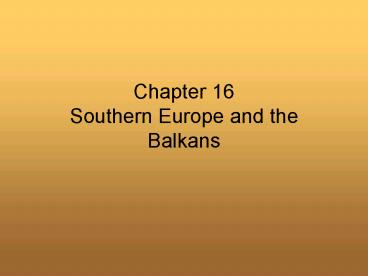Chapter 16 Southern Europe and the Balkans - PowerPoint PPT Presentation
1 / 15
Title:
Chapter 16 Southern Europe and the Balkans
Description:
2. Anzar administration deregulated the economy and lowered unemployment but still high at 11 ... culture developed during the Renaissance. 3. Main meal in the ... – PowerPoint PPT presentation
Number of Views:437
Avg rating:3.0/5.0
Title: Chapter 16 Southern Europe and the Balkans
1
Chapter 16Southern Europe and the Balkans
2
- Section 1The Iberian Peninsula
- Shared by Spain and PortugalSpain covers 85
- Spain
- History and Government
- 1. Controlled by the Moors from North Africa
kicked out in 1492. - Architecture
- 2. Spanish Empire
- a. one of the largest by 1500s, finished
by end of 1800s. - Civil war 1936-1939 between monarchists and
pro-democracy forces. - Monarchists won Francisco Franco ruled from
1939-1975.
3
- 4. Quick transition to democracy after Francos
death - 5. 17 autonomous regionswanted independence in
1975. - People and Culture
- 1. Most are Roman Catholic
- 2. Speak Castilian Spanish
- 3. Plaza
- 4. Moorish influence
- Economy
- 1. manufactures a variety of products
- 2. Anzar administration deregulated the economy
and lowered unemployment but still high at 11 - 3. Member of the EU
4
- 5. Agriculture
- a. olive oil and wine
- b. oranges grown in ValenciaMoors
- c. corn, potatoes, tomatoes imported from
American colonies - Issues and Challenges
- 1. Economic improvement GDP is 80 of Europes
four most industrialized countries. - 2. Immigration from North Africa
- 3. Basque SeparatistsETA terrorists
5
- Portugal
- History and Culture
- 1. Influenced by Moors
- 2. Had a colonial empire
- Economy
- 1. declined after they lost their empire
- 2. GDP is 70 of the most developed
- 3. EU member
- 4. Performed above European average in 1990s.
- 5. Cork
6
- Section 2Italian Peninsula
- History
- 1. Roman Empire
- a. Europe, North Africa, Southwest Asia
- b. Diffused language, government,
architecture and religion - 2. Renaissancerebirth. Renewal in
learning1300s to 1500s. - 3. United in 1861
- Benito Mussolini--
- allied with Hitler, overthrown in 1943.
- 5. Prospered since World War II
7
- People and Culture
- 1. Roman Catholic and speak Italian
- 2. Modern culture developed during the
Renaissance - 3. Main meal in the middle of the day
- 4. Central Italy is the political and cultural
centerRome - 5. Unstable governments since World War II
- a. 50
- b. No party can form a majority, or
temporary alliance
8
- Today
- 1. North is prosperous and the south is
poorer20unemployment. South is aided by EU and
Italian government. - 2. Rich farmland in Po River Valley
- Issues and Challenges
- 1. Developing southern Italys economy
- 2. Lower birthrate and older population
- 3. Pollution is hurting older buildings
- 4. Continue mafia crackdown, particularly in
Sicily.
9
- Yugoslavia
- Yugoslavia created in 1918.
- Serbs, Croats, Slovenes.
10
- After WWII
- Marshall Josip Tito
- Held Yugoslavia together through force of will.
- Tito successfully resisted the Soviets.
11
(No Transcript)
12
- Disintegration in 1990s
- Along ethnic lines
- Slobodan Milosevic--Serb
- Create a Greater Serbia.
- Ethnic conflict perpetrated by the Serbs
- Ethnic Cleansing
- Balkanization
13
- Dayton Accords-1995
- Slowed down Serbias efforts at ethnic cleansing
- NATO sent 60,000 troops.
14
- Kosovo
- Effort by the Serbs to remove ethnic Albanians
and Muslims. - U.S. responded with force in 1999. NATO still
there.
15
- Conclusion
- Milosevic arrested in 2001. Died in the Hague.
- Slovenia is most unscathed. Other countries
still suffering.































